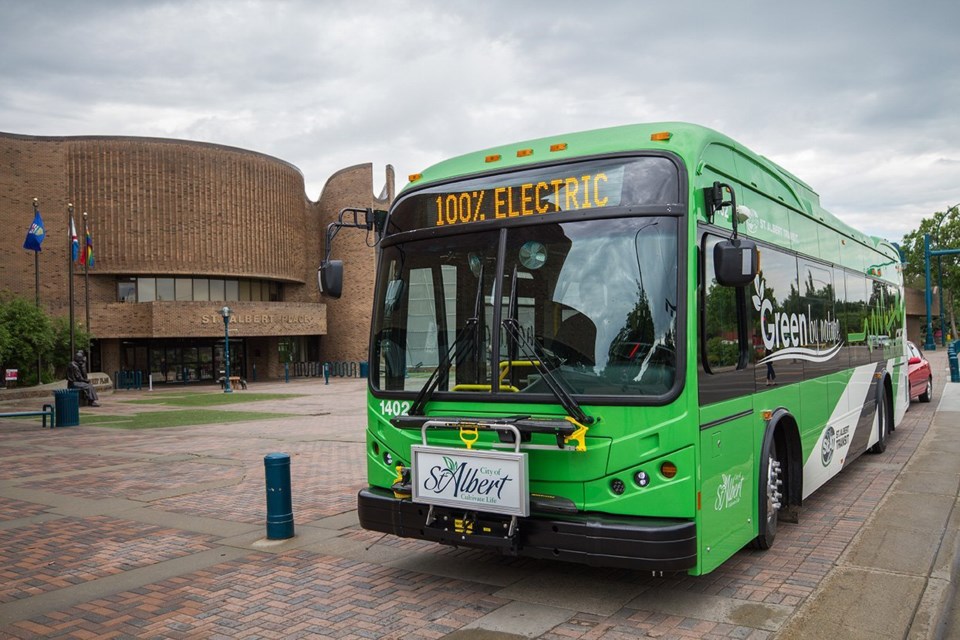St. Albert Transit has unveiled plans to make transit riders feel more comfortable getting back on the bus.
Transit staff started giving out 50,000 non-medical face masks from the province on Tuesday. City staff are also continuing to pursue options to buy surplus transit barriers from the City of Edmonton for a discounted price.
On June 30, transit staff will be handing out masks at the Village Transit Station, located on Grange Drive, from 6 a.m to 8:15 a.m. and 3:30 p.m. to 6 p.m. This will be done on a first-come, first-served basis, and any additional distribution dates will be announced depending on supply.
"According to the Government of Alberta, face masks are not mandatory, but provide riders with an option in situations where maintaining a physical distance of two metres is not possible," said Anthony Lake, director of public works and transit, in an email to the Gazette.
Distributing face masks through public transit would also help bridge the gap for people who weren't able to get them through select fast-food chain drive-thrus, the city said.
Safety shields
On June 15, Coun. Wes Brodhead brought forward a motion for city staff to look into purchasing surplus transit barriers from the City of Edmonton for up to $400,000 to upgrade the city's fleet. This would be done using funds from the stable transit reserve and the Repair, Maintain, Repair (RMR) reserve funds.
The cost to purchase these transit barriers would be at least a third higher if the city were to do this on its own, Lake said – between $650,000 to $700,000. The shields are worth $12,500 U.S. per unit, and are being offered to the city at $8,500 Canadian per unit, Brodhead said.
Locally and nationally, transit unions have been lobbying for these shields to protect drivers.
The union representing bus drivers in St. Albert made a plea to city council April 14 that current disinfection practices on buses are not sufficient, and called for the city to follow the lead of other transit systems across North American that have installed bus shields to protect drivers.
"Opportunities like this come knocking at your door once. Recognizing that, it comes at a time when we're pressed as a community because of the costs associated with COVID-19," Brodhead said.
"We have an opportunity to not only protect our drivers physically but in a substantial way from COVID exposure at a substantially reduced cost."
Barrier delivery is being arranged this week and installation options will be presented to council, Lake wrote. One of the options is to have the city do the installation in-house to avoid additional costs.
With ridership fares reinstated July 1, Brodhead said the city recognized the importance of making sure operators have some form of protection from people coming in through the front doors to pay. A simple plastic barrier wouldn't do the trick, he said.
"We had an opportunity to pick up these robust safety shields from Edmonton, which is the going state of the art for not only providing the safety of the operator but by virtue of the plastic shield, providing a barrier to enhance COVID-19 protection as well," he said.
Safety concerns and public safety measures due to COVID-19 took a drastic toll on ridership numbers. In June, public transit ridership was down 79 per cent, according to the city.
With new safety measures coming for St. Albert transit, Brodhead said he's hopeful riders will feel safe taking public transit again.
Physical barriers, face masks, sanitization and physical distancing are all part of creating a safe environment for riders.
"One of the big barriers to overcome is not only the reality of dealing with COVID-19, but the perception of COVID-19 and the risk associated with riding on public transit," he said.
"There's a certain percentage of the population that are going to feel uneasy in any sort of public setting prior to a vaccination, and that's understandable. But what we want to do is provide the very best possible options for our riders to come on and feel a level of confidence in being able to ride public transit in safety."


.jpg;w=120;h=80;mode=crop)

